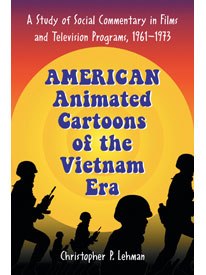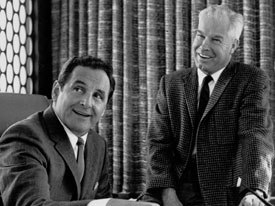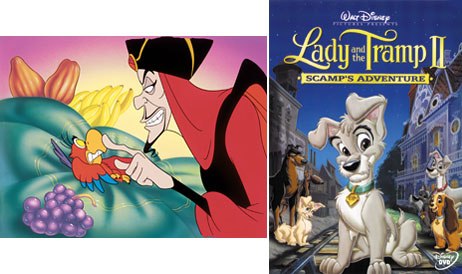This month, Martin "Dr. Toon" Goodman looks at the caveat that stuck out in Christopher P. Lehman's American Animated Cartoons of the Vietnam Era about the intent of artists to bring social issues to their cartoons.

I.
When this summer ends, I will have written this column for 10 years (two for the former Animation Nerd's Paradise and eight for this esteemed website). That will equal roughly 120 monthly commentaries on animation, typically animation as it relates to American culture. Although I'm sure that luminaries, such as Maureen Furniss and John Canemaker might disagree, I continue to be amazed at how rich this vein is when mined. From the simple premise that American culture and American animation have a subconscious resonance, as well as a surface connection that is instantly interpretable, one can find enough material to entertain one's self (and hopefully, one's readers) for months to come.
However, a note of caution is definitely in order. When interpreting the matrices between animation and its attendant culture, one needs to be sure that one paints a careful picture. I have already spent several columns demonstrating how the deconstructive/semiotics movement often produces laughable parodies of animation criticism simply by ignoring such inconvenient items as history, facts, contexts and the actual stated intent of the animators. I have recently come across a fascinating book that explores a connection between animation and American culture of a particular era, and I recommend it heartily, save for one small but important caveat.
Christopher P. Lehman, assistant professor in the ethnic studies department at St. Cloud University, Minnesota, has written one fine book, American Animated Cartoons of the Vietnam Era. He has evidently watched every cartoon he quotes and references, and not the same can be said for all authors in the field. The book is subtitled, A Study in Social Commentary in Films and Televisions Programs, 1961-1973. Lehman's core thesis is that cartoons slowly switched from a militaristic and violent milieu to a more liberal and pacifist bent as the costly and unpopular war ground on.

Lehman expands this viewpoint to include many cultural issues of the era, including those related to race relations and the civil rights movement. Lehman's genius in this regard is picking up some of the subconscious resonance referred to earlier. The issue I had with some of Lehman's writing, however, and this refers to the caveat I mentioned, is that the author is more assertive than suggestive at times, and this can be problematic in a number of ways. It is one thing to suggest that certain parallels between the racial situations in America during the Civil Rights era were unconsciously picked up from the culture and transposed into cartoons. It is another thing to say that it seems that this was the direct intent of the artists.
To give an example of the difference, Lehman's examination of the 1963 Warner Bros. cartoon short, Banty Raids (p. 43-45 is an excellent piece of analysis, in part because Lehman is careful to note a subconscious context when referring to the beatnik rooster in the short. Lehman notes that Foghorn Leghorn's disdain for the rooster, "has some parallels to the white South's negative response to the early counterculture." This is acceptable language for such conjecture, as it is more assumptive in nature. Unless we know the exact purpose of the creator, assumptive methods in interpretation are the safest route to go.
Where Lehman's analysis becomes problematic is when statements such as the following are made:
And again, in reference to Magilla Gorilla and Wally Gator, respectively:
This is dangerously close to deconstructionism, but the implications of these declarative statements are a bit more disturbing. By not stating that the Hanna-Barbera cartoons of the early 1960s unconsciously (or unwittingly, or uncannily) paralleled issues in civil rights, Lehman runs the heady risk of stating that the studio produced these cartoons with the preservation of the prevailing racial status quo in mind. This may seem like an exercise in semantics, but consider this: There is a large difference between picking up on the vibes of the times and having them indirectly resonate in a certain medium, and making a blunt statement of intent in that same medium.

It is highly unlikely, given from what we know about Bill Hanna and Joe Barbera, that they were interested in impeding the repeal of segregation. Although the pair did evidence some racial stereotyping in their early Tom and Jerry cartoons, such depictions were, at the time, not unusual in Hollywood cartoons. In fact, many studios pushed the envelope much farther. Hanna-Barbera was also careful throughout the 1960s to integrate black characters into its cartoons (that were equally as bland as the white ones. How's that for equality?) If you have great difficulty in picturing Hanna and Barbera deliberately designing their funny animal cartoons with an eye on backing up old Jim Crow, you would have plenty of company.
Actually, I don't believe that anyone as intelligent and incisive as Lehman pictures it, either. The author simply, in my view, lost sight of the fact that an assumptive statement is very different from a declarative one. On such tiny differences, however, are valid critiques of animation balanced. Even so, do yourself a large and satisfying favor. Order this wonderful book as soon as possible and prepare yourself for a great read in cultural studies and animation.
II.
The Jabberwock, with its jaws that bite and claws that catch, is dead. John Lasseter and Steven Jobs killed and buried the beast with the recent and timely announcement that Disney was no longer going to produce direct-to-video sequels of their classic films. Even though the practice was quite lucrative, Lasseter and Jobs decided to go with tradition, purity and dignity. After the much-awaited (heh!) release of The Little Mermaid III, this odious practice will cease, to be replaced by original direct-to-video animated stories.
The Disney descent into sequel Hell began in 1994 with The Return of Jafar. This follow-up to Aladdin was relatively inoffensive; the film was a recent one and the sequel actually made some sense. Three years later,d Disney began treading more treacherous waters with Beauty and the Beast: The Enchanted Christmas. Not only was the animation not up to par, the attempts to fill in gaps in a film that was nearly perfect in its original structure began to feel more like a cash-in than an attempt to add depth to the original telling.
It wasn't until 2002 that Disney stepped into the deepest cantos of Hell with Lady and the Tramp II: Scamp's Adventure (scathingly commented upon by yours truly in my column). Sequel-itis had now crept into films that were produced when Disney and his Nine Old Men were still alive and turning out features that were on the outer fringe of "Disney classics." The next year, Cinderella would get a sequel. Purists railed loudly, but the cash registers sang.
The ultimate affront likely occurred just as Disney was purchasing Pixar and the names of those directing the company's fortunes were changing radically. The month after Jobs and Lasseter ascended to power, DisneyToon Studios released Bambi II. It is one thing to have the Prince of the Forest drop in at Disney's House of Mouse; it is quite another to cobble together an inappropriate sequel to one of Disney's seminal films.
And now, mercifully, it ends. As far back as 2003, Jobs stated, "We feel sick about Disney doing sequels. If you look at the quality of their sequels... it's pretty embarrassing." Jobs were right in many respects. The direct-to-video efforts featured second-rate animation and scripting more worthy of TV specials. They often appeared (as in Cinderella III: A Twist in Time) to be so detached from the original effort and flavored by contemporary themes that they did not seem like the continuation of a classic. They felt more like a pilot for a TV series that didn't pan out.
Jobs could have gone even further. The videos were embarrassing, true, but so was the entire idea to begin with. Often, the direct-to-video sequels were needless, since many of the original films were continued as TV series on the Disney Channel. The end of an era usually brings sadness, regret and years later, a feeling of nostalgia for things gone by. In this case, the end of an era is more a cause for rejoicing. Not only will we be spared Snow White II: The Secret of Dope's Mine, we will never be subjected to Chicken Little II either. Indeed, the only good Jabberwock is a dead one.
Martin "Dr. Toon" Goodman is a longtime student and fan of animation. He lives in Anderson, Indiana.








